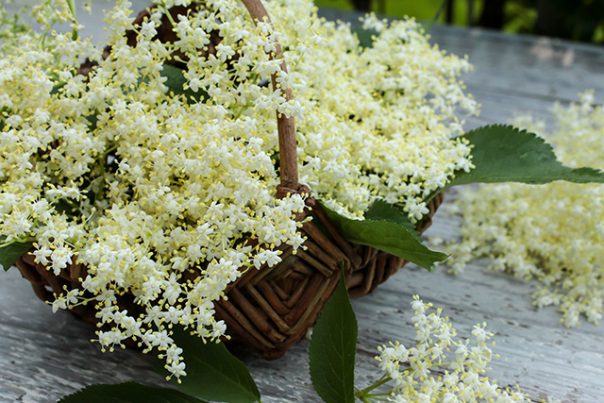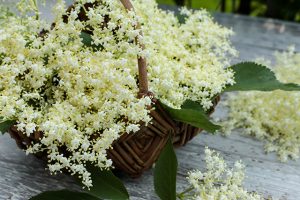
Elderflower – sources, health benefits, nutrients, uses and constituents at NaturalPedia.com
Thursday, July 06, 2017 by Frances Bloomfield
http://www.naturalpedia.com/elderflower-sources-health-benefits-nutrients-uses-and-constituents-at-naturalpedia-com.html

Elderflowers are the small, white or cream-colored flowers of elder or elderberry (Sambucus) trees. There are over two dozen known species of elder trees, with the some of the most popular ones being European or black elder (Sambucus nigra), Asian dwarf elder (Sambucus adnata), and Mexican elder (Sambucus mexicana). For thousands of years, elderflowers have been used by different cultures to treat all types of medical conditions, from the common cold to skin irritations to allergies.

List of known nutrients
Elderflowers contain an abundance of bioflavonoids, specifically flavones and flavonols. These are powerful phytochemicals that naturally occur in vegetables, fruits, and herbs. The bioflavonoids found in elderflowers are noteworthy for their antioxidant, anti-inflammatory, and antibacterial properties, all of which have contributed to the plant’s frequent use in traditional medicine.
Apart from flavonols and flavones, elderflowers possess other nutrients and active ingredients, primarily:
- Choline
- Cinnamic acid
- Omega-3
- Omega-6
- Pectin
- Tannins
- Triterpenoids
- Vitamin C
Medicinal uses for elderflowers
Elderflowers can greatly reduce the symptoms of common allergies, such as those associated with pollen allergy and sinusitis. Generally, however, elderflowers are known to be effective in treating respiratory disturbances.
Elderflowers can also be used for:
- Acne
- Arthritis
- Colds
- Constipation
- Influenza
- Methicillin-resistant Staphylococcus aureus (MRSA)
- Skin rashes
Body systems supported by elderflowers
Quercetin, a flavonol in elderflowers, has been found to be effective at lowering cholesterol levels. Reduced cholesterol levels entails less stress on the heart, making elderflowers effective at maintaining the health of this important muscle.
Taking or using elderflowers can support:
- Immune System
- Respiratory System
- Skin
Ways to use elderflowers
The most common and most well-known way of taking elderflowers is as a cordial. An infusion of elderflowers, sugar, and lemons makes for one refreshing cordial. This cordial can then be used in sweet recipes, such as those for pudding, panna cotta, and ice cream.
On their own, elderflowers can be turned into relishes, chutneys, and jams. Furthermore, dried elderflowers can be made into tea.
Note: Although elderflowers are usually safe for human consumption, the same cannot be said of the roots, twigs, leaves, and berries of the elder plant. These parts have glycosides, or compounds that release cyanide if eaten. Of all all elderberries, the only truly edible ones are those from the black elder, and even then they should never by eaten raw.
Where to learn more
- 6 holistic approaches to a fever
- Common Sense Recommendations for Avoiding and Treating the Swine Flu
- How to Beat and Prevent the Avian Flu and Other Influenzas
- How to Treat High Blood Pressure Naturally with This Tasty 4-herb Tea
- Use Natural Remedies for the Treatment of Allergies
Summary
Elderflowers have average anti-mucus and expectorant qualities, which makes them excellent choices in combating the common cold and flu.
One unusual way elderflowers can help out the body is through their use as a diaphoretic. By inducing sweating, elderflowers can expel toxins, prevent the body from overheating, and clean the skin’s pores. Sweating can even assist in fever reduction by bringing the body’s temperature back to normal.
In addition to the bioflavonoids, elderflowers contain vitamin C, a vitamin which acts as a powerful antioxidant. This vitamin is potent on its own, but combining it with bioflavonoids allows the body to maximize the health benefits of this vital nutrient. Vitamin C is most known for strengthening the immune system and for protecting the body from harmful free radicals.
Elderflower extract possesses healing qualities that can be used to improve a variety of skin conditions, ranging from acne to skin rashes to skin infections.
Those who suffer from swollen joints can turn to a topical application of elderflowers too reduce the pain and swelling.
Elderflowers are an average antiseptic and do well as an oral rinse.
Consuming large amounts of elderflowers may cause gastrointestinal disturbances like diarrhea or nausea.
Sources include:
HerbWisdom.com
FitHog.com
TheSpruce.com
NatureWord.com
101HealthyRecipes.com
Tagged Under: Tags: Elderflower





